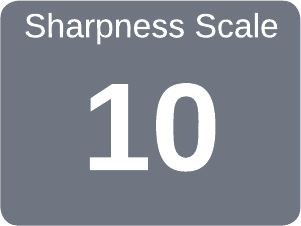
Edge angles
Detail Gouges and Spindle Gouges are different in the shape or depth of the flute. (This article by Joe Larese, “A Guide to Gouges” gives a good overview of the differences.)
Regardless of the flute, the sharpening is the same.
Guidelines shown below are for use with the Tormek Spindle Gouges (SVD-186 R, SVD-186, or SVD-185).
|
Without craftsmanship, inspiration is a mere reed shaken in the wind.
Unknown
|
|
General Guidelines
|
|
α
|
Relief (if used)
|
SVD-186
|
Sharp
ness
|
Comments
|
|
JS
|
P
|
Hole
|
|
30°
|
5° - 10°
|
2
|
55 mm
|
B
|
|
α can range from 30° - 40°.
For tight spots, detail work and finest finish. When the flute is shallow, this is known as a Detail Gouge. Traditionally, the wings are swept back quite far.
Not recommended for starter-level turners.
|
|
45°
|
5° - 10°
|
2
|
65 mm
|
A
|
|
α can range from 35° - 45°.
Standard profile. For turners of all skill levels.
|
Notes & Comments
Other Opinions
Marty Kiminsky noted "Woodturning" magazine (issue # 352) these α angles for gouges:
|
Gouge Type
|
Generally Recommended
|
Personal Preference
|
|
Detail Gouges
|
40°
|
40°
|
|
Spindle Gouges
|
25° - 40°
|
40°
|

Comparison of two bowl gouges; one old, one new
Tool Too Short?
When the tool gets too short to be held by the jig, you may be able to grind off the top as shown in the upper tool in the picture to the left. This flat area allows for the jig to hold the tool without the tool slipping or rotating.
Or, when the tool gets too short to be held by the jig, consider making it into a beading tool (video).

Example icon
Sharpness Scale
Sharpness scales (as shown in the grey icon to the left) are used to indicate the recommended sharpness for the blades noted above. You can click on any of the icons showing the sharpness scale and be redirected to the page describing this more. Lower numbers are duller; higher numbers sharper.
These are general recommendations; you will need to use your own judgment, based on the knive’s intended purpose.
More Information
Books & Papers
Published Articles
Videos & Presentations
- Alan Holtham
- David Peters
- Tormek
- Tormek Sharpening Classes: Part 5 - Woodturning Tools (YouTube video). Want to learn how you get your woodturning tools razor-sharp? In this week's sharpening class we take a closer look at the tools for the woodturner; Gouges, skews, parting tools, scrapers, cutters and more. Sèbastian and Wolfgang will show you the methods for sharpening all these turning tools and how you achieve repeatable edges every time. Stay tuned and hit us with your questions during the stream.
- Tormek Live Sharpening Class - Part 9 - Sharpen a flat bevel with Tormek MB-100 on a diamond wheel (YouTube video). Sèbastian and Wolfgang show how to achieve a flat bevel with your Tormek wet sharpening system, They also touch upon the differences between the different types of bevels.
- Tormek Sharpening Classes: Part 23 - Reshaping woodturning tools on a bench grinder (YouTube video). In this episode of the Tormek sharpening classes we explain how you can quickly and with full control, re-profile your turning tools on your bench grinder. The BGM-100 Bench Grinder Mounting Kit allows you to use the same jig settings as on your water-cooled Tormek sharpening system. It is therefore easy to do the rough shaping on the bench grinder and then continue to sharpen and maintain the edge of your Tormek machine.
|
|



